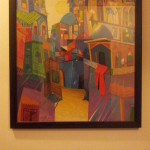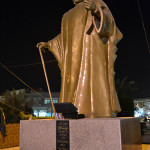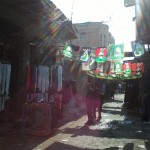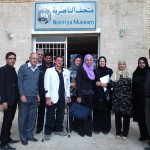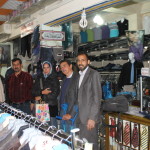Nasiriyah is the main city of DHi-Qar Governorate. The city lays on the Euphrates about 370 km southeast of Baghdad, near the ancient city of Ur. The estimated population in 2003 was 560,200.
The population of Nasiriyah is nearly exclusively Shī‘a Muslims with small Mandaean and Sunni muslim communities, and only one Christian family (that we met during the celebrations of the end of the Year of Faith hold under the Ziqqurat – see our blog http://www.abutbeirah.com/blog/?p=736 ).
The city, founded in 1872 by Sheikh Nasir Al Sadoon, is famous for its cultural life and especially for its poets: the main square, in the center of the city is dedicated to the poet Habubi.
During the first campaign in Abu Tbeirah we had the opportunity to visit the center Mandaean which I’ll discuss in the next blog.
Among the artists coming from the city there is also Kamil Al-Mosawi, whose house we visited during the last February. His paintings are wonderful and colorful pictures of Iraq (one of this is now in my house and shows a city similar to those narrated in A Thousand and One Nights)
Some of the other thinkers, singers, artists and poets who lived in the city area were Aziz al Syed Jasim, Aziz Abdul Sahab, Sadiq Atemish, Mohamed Ali al-Nasiri, Ayniah alHusewani, Aryan Syed Khalif, Hazery Abu Aziz, Taleb al Qayraqwli, Hussein Nameh, Huessien al Halali, Majed al Najar.
The Nasiriyah market is a wonderful place in which you can buy everything you desire from the latest high-tech devices to scented spices and colored tissues. I had the opportunity to go there with my colleague and friend Wasan Aesa: it was an unforgettable experience!
Nasiriyah has also a wonderful museum, where a lot of archaeologist, our friends and colleagues, are now working in order to restore it and to open it to the public.
We are looking forward to see the exhibition of our findings in their rooms!
Nassiriya è la città principale del Governatorato del Dhi Qar. La città è situata sull’Eufrate circa 370 km a sud est di Baghdad, nei pressi dell’antica città di Ur . La popolazione stimata nel 2003 era di 560.200 persone.
La popolazione di Nassiriya è quasi esclusivamente sciita con piccole comunità di mandei e sunniti, e una sola famiglia cristiana (che abbiamo incontrato durante le celebrazioni della fine dell’Anno della Fede tenere sotto la Ziqqurat – vedi il nostro blog http://www.abutbeirah.com/blog/?p=736 ).
Durante la prima campagna ad Abu Tbeirah abbiamo avuto la possibilità di visitare il centro Mandaico di cui parlerò nel prossimo blog.
La città , fondata nel 1872 dallo sceicco Nasir Al Sadun, è famosa per la sua vita culturale e soprattutto per i suoi poeti: la piazza principale, nel centro della città, è dedicata al famoso poeta Habubi.
Tra gli artisti provenienti dalla città c’è anche Kamil Al-Mosawi, la cui casa abbiamo visitato durante l’ultimo mese di febbraio. I suoi dipinti sono immagini splendide e colorate dell’Iraq (uno è adesso a casa mia e mostra una città simile a quelle narrate ne Le Mille e una Notte).
Tra gli altri pensatori, cantanti, artisti e poeti originari della città si possono citare Aziz al Syed Jasim, Aziz Abdul Sahab, Sadiq Atemish, Mohamed Ali al – Nasiri, Ayniah alHusewani, Aryan Syed Khalif, Hazery Abu Aziz, Taleb al Qayraqwli, Hussein Nameh, Huessien al Halali, Majed al Najar .
Il mercato Nassiriya è un posto meraviglioso in cui è possibile acquistare tutto quello che si desidera, dai più recenti dispositivi high-tech alle spezie profumate e ai tessuti multicolori. Ho avuto l’opportunità di andare lì con la mia collega e amica Wasan Aesa: è stata un’esperienza indimenticabile !
Nassiriya ha anche un museo meraviglioso, dove tanti archeologi, nostri amici e colleghi , stanno ora lavorando per restaurarlo e aprirlo al pubblico. Non vediamo l’ora di avere i nostri reperti esposti nelle loro sale!
